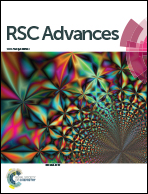Active methylene compounds (AMCs) controlled facile synthesis of acridine and phenanthridine from morita Baylis–Hillman acetate†
Abstract
We carried out simple and facile syntheses of acridines and phenanthridines from MBH acetates of 2-chloro-quinoline-3-carbaldehydes with active methylene compounds (AMCs). Formation of products was found to be dependent on the functional group of the AMC. For example, ethylcyanoacetate and malononitrile favoured the formation of acridines and cyanoacetamide, and ethyl nitroacetate and malonic esters favoured formation of angularly-fused phenanthridines. The reactions leading to the formation of phenanthridines proceeded through single bond rotation of SN2′ intermediate which was attributed to electronic/steric repulsion between the functional groups of AMCs and the nitrogen of quinoline.



 Please wait while we load your content...
Please wait while we load your content...